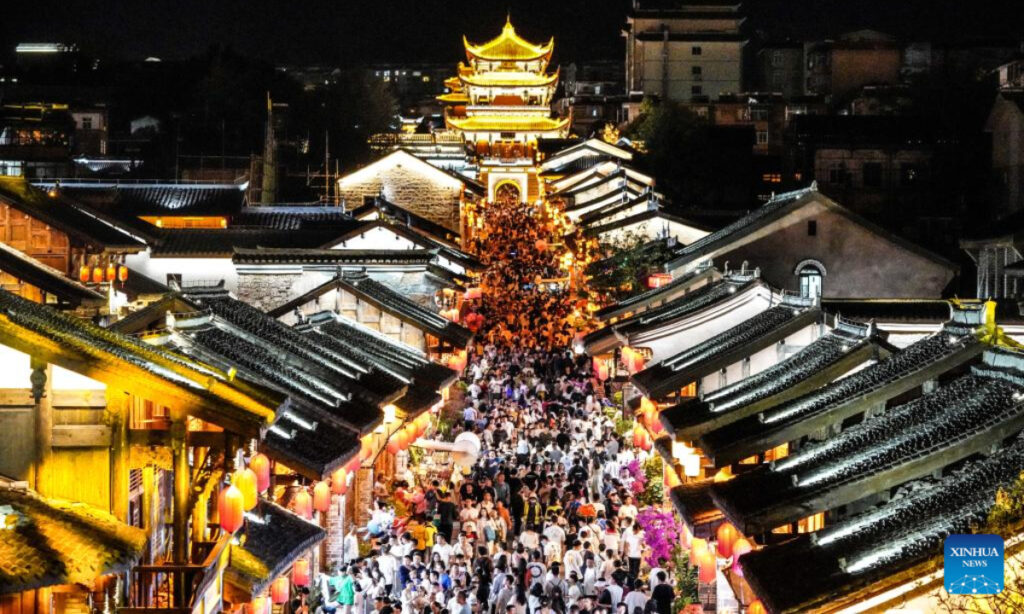Strong momentum expected to last as economic pickup continues
Major Chinese cities including Beijing and Shanghai have seen a full recovery in the tourism and consumption sectors during the recent three-day Dragon Boat Festival holidays, with certain indicators exceeding that of 2019 before the COVID-19 pandemic, according to official data on Sunday.
The data offered more signs that China’s economic recovery continues on a steady path, despite downward pressure, analysts noted, dismissing foreign media claims of softened consumption power.
In Beijing, 216 tourist attractions welcomed 5.19 million visitors for the holidays, recording a 2.1 percent growth comparing with the same period in 2019, official data showed on Sunday. That generated a revenue of 309.09 million yuan ($43.05 million), up 5.8 percent from the same period in 2019.
In addition to travel-related consumption, Beijing also saw a boost in entertainment revenue. A total of 708 performances were held during the holidays, which attracted more than 200,000 viewers and generated nearly 60 million yuan through ticket sales. The number of performances increased 125.5 percent compared with the same period in 2019, while ticket sales jumped 156.6 percent.
“Despite the recent heat waves in Beijing, I could still see crowds of people in multiple scenic spots especially indoor locations when I took my son out,” a Beijing-based white-collar surnamed Ma told the Global Times on Sunday.
Meanwhile, around 6.23 million tourists visited Guangzhou, another popular destination in South China’s Guangdong Province for the holidays, recording a year-on-year increase of 32 percent and a 4.5 percent growth compared with 2019, according to local official data. The provincial capital achieved a total income of 3.47 billion yuan, a yearly surge of 58.2 percent.
The number of visitors and consumers on subways, shopping malls and restaurants in Guangzhou noticeably surged during the Dragon Boat Festival holiday, Zhang Yi, CEO of iiMedia Research Institute, told the Global Times on Sunday, adding that he personally did not notice people around who downgraded or stopped consumption.
Shanghai received 6.72 million visitors during the festival, generating 9.61 billion yuan in revenue, the paper.cn reported. More than 9 million trips were made through the railway in the Yangtze River Delta region with an average of three million travelers per day, an increase of more than 20 percent over the same period in 2019.
Experts remain confident and optimistic over China’s overall consumption pickup amid its steady economic recovery, especially as the market is experiencing structural upgrading.
The development of the culture and tourism sector is a significant representation of the consumption upgrading for China’s market as consumers have further elevated their standards and expectations for product and service quality, Cong Yi, dean of the School of Marxism at Tianjin University of Finance and Economics, told the Global Times on Sunday, adding that sectors such as culture and tourism have a huge development potential amid the transitioning.
Chinese consumers have the capability and potential for spending, said Cong. He expressed optimism about China’s continued economic recovery for the rest of 2023 following supportive measures and the gradual restoration of production.
The National Development and Reform Commission, China’s top economic planner, said earlier in June that it would accelerate the formulation and implementation of policies to restore and expand domestic consumption, aiming to continuously improve the consumption environment and unleash the potential for service consumption.
Zhang added that the rebounding in post-epidemic consumption has been reflected by the booming demand for traveling, which stimulated the consumption simultaneously. For instance, Zhang said, occupancy rate of recent flights have been significantly increased based on their institutional research.
Some 106 million domestic tourism trips were made during the holidays, a year-on-year increase of 32.3 percent, and equivalent to 112.8 percent of the figure in 2019 before the COVID-19 pandemic. Domestic tourism revenue reached 37.31 billion yuan, up 44.5 percent year-on-year, according to data from the Ministry of Culture and Tourism released on Saturday.
The numbers also proved a recovering consumption power from domestic shoppers despite some Western media hype about softened consumption during the “618” online shopping festival.
Zhang stressed that domestic consumers now have been diversifying their shopping patterns to different platforms rather than just sticking to the traditional e-commerce giants, while their spending is not entirely confined to a specific holiday or shopping festival, so foreng media claims based purely on unrevealed sales numbers or limited data is not objective.
For instance, sales on Douyin’s e-commerce platform from May 31 to June 18 increased 66 percent year-on-year, with the accumulative livestreaming period lasting 42.02 million hours, the company said on its official Wechat account.
Cong noted that some consumption figures from the “618” shopping festival may only reflect the quantity of consumption for certain timing without showcasing consumers’ increasing demand for higher quality amid the structural upgrading.
(Global Times)




